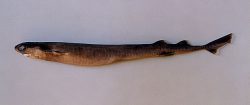select your film:


The Largetooth Cookiecutter Shark is a rare species of dogfish shark in the family Dalatiidae, found in scattered locations between the Atlantic and the Pacific oceans.
Biology and Description:
The Largetooth Cookiecutter Shark has a long, cigar-shaped body with a short, blunt head and snout. The large, oval eyes are positioned to allow binocular vision and are followed by wide spiracles. The nostrils are small with pointed skin lobe on each. The mouth is transverse and jaws are larger and more powerful than that I. brasiliensis, and contain fewer tooth rows, numbering 29 for the upper jaw and 19 for the lower jaw. The five pairs of gills are minute. The small dorsal fins have rounded apices and are placed back on the last third of the body. The pectoral fins are small and rounded and position relatively high on the body. The pelvic fin is also tiny and there is no anal fin. The caudal fin is very short, with the upper lobe twice as long as the lower lobe. Its colour is a plain dark brown, with translucent margins around the fins and sparsely scattered light-emitting photophores on the belly. The maximum length recorded on this species is 42 cm TL.
Based on its small caudan and dorsal fins, this species is believed to be less active than I. brasiliensi and an overall weak swimmer. The Largetooth Cookiecutter shark is an ectoparasite that feeds by excising plug of flesh from larger animals, by employing a “sweeping” bite that produces a much larger and elongated oval wound containing parallel tooth groves.
There is no much information regarding its biology, but this shark is presumed to be aplacental viviparous.
Habitat:
The Largetooth Cookiecutter shark is epibenthic (-100 m depth over the continental shelf) and epipelagic (depths of 60 to 120 m over continental slopes). This species is distributed from the Atlantic (off Alabama, USA and the Gulf of Mexico; including Brazil and West Zahara and off Azares) and Northwest Pacific (off Okinawa, Japan and Australia).
Conservation:
The Largetooth Cookiecutter shark s rarely caught incidentally in trawls. There are currently no conservation measures in place for this species. Further investigation is required to better define distribution and obtain information on biology.
Do you have images or videos of Largetooth Cookiercutter Sharks?
Submit them to [email protected].
